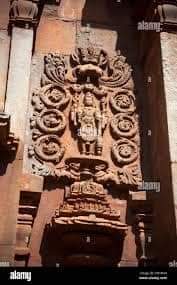The Chandramauleshwara Temple, sometimes referred to as the Candramauḷisvara or Chandramouleshwara temple at Unkal, is an 11th century Shiva temple with Chalukyan architecture in Unkal (Hubballi), Karnataka, India.
The temple has a square
plan architecture with four entrances from the cardinal directions, while
illustrating the sandhara plan found in Sanskrit texts on architecture. It
originally had a Chaturmukha (four-faced) Linga in the center of the temple and
many more mandapas (halls), but the surviving structure is much smaller. The
temple preserves an early example of a relatively uncommon Hindu architecture.
The temple is also notable for how it integrates the artwork of Shaivism,
Vaishnavism, Shaktism and Vedic deities together.
Chandramauleshwara temple
at Unkal
Creator Bommanna
Dandanayaka
Chandramouleshwar is a
monument from the Kalyana Chalukyan era. It lacks a foundation inscription, and
its date thus has to be indirectly inferred by other inscriptions that mention
it, architectural style and iconographic details. According to Dakhy and Meister
– scholars known for their encyclopaedia on India temple architecture and
history, these factors suggest that "a date no later than the eighties of
the 11th-century seems admissible".
The presence of two
12th-century stone inscriptions in Unkal village show that the temple was built
in or before the 12th-century. The Archaeological Survey of India assigns it to
the 12th-century.
Architecture
Chandramouleshwar
Four-faced Shiva lingam, one of the face from side.
The temple is a
remarkable building that illustrates the sandhara plan, with a square
garbhagriha that can accessed from four cardinal directions. This open from all
sides plan comes with four molded walls each with decorated doors. The
doorjambs are decorated with pancha shakhas (five concentric band of fine
carvings), but the artisans made each door unique. The eastern door is
particularly excellent, one of the best from the 11th-century. Each door has a
pair of dwarapalas. The temple includes a pradakshina patha for
circumambulation. It also has an antarala and a sarvatobhadra-style
mukhamandapa.
The outer walls include the architectural and decorative details in major Hindu temples, but to accommodate the four entrances, the temple integrates ardha-mandapas that function as antaralas. The original temple had mukhamandapas on the north and south side for the pilgrims to gather, but that is now lost and only mutilated and damaged sections of these sections can now be traced. The details in and above the mancabandha adhistana are elegant, with a band of flowers, then alternating horse-elephant rajasena, above which is the vedikas with miniature but beautiful musicians, then gandharas framed between aedicules, topped with wood/jewel-like detail kaksasana carvings.
The jalas in this temple are of two types – gulika and puspakantha – both elegantly completed, with timber-like finish.
The jalas in this temple are of two types – gulika and puspakantha – both elegantly completed, with timber-like finish.
Originally, the temple
housed the image of Chaturmukha linga at the very center so that the pilgrim
could see one face of Shiva no matter where she or he stood. However, at some
point, this was moved and it is now in the western side of the temple. One
possible explanation was offered by Henry Cousens after his survey of this
site. The temple likely suffered destruction after the 13th-century, went into
disuse. The "very dilapidated" temple was later appropriated by
Lingayats who moved the Chaturmukha linga and replaced it with a plain linga
they preferred.
The outer walls of the temple have niches framed with pilasters. These depict a galaxy of deities and Hindu legends from all the major traditions within Hinduism: Brahma, avatars of Vishnu, and various forms of Siva. Of particular note are the Nataraja, Narasimha, dancing Ganesha, Sarasvati and Mahishasurmardini. Another notable feature here is that two of the four lalitabimbas into the sanctum have Gajalakshmi and two have Sarasvati, a fact that led Cousens to suggest that this temple may be much older than the 11th century and might once have been a Brahma temple.
.jpeg)
.jpeg)
.jpeg)
.jpeg)
.jpeg)
.jpeg)
